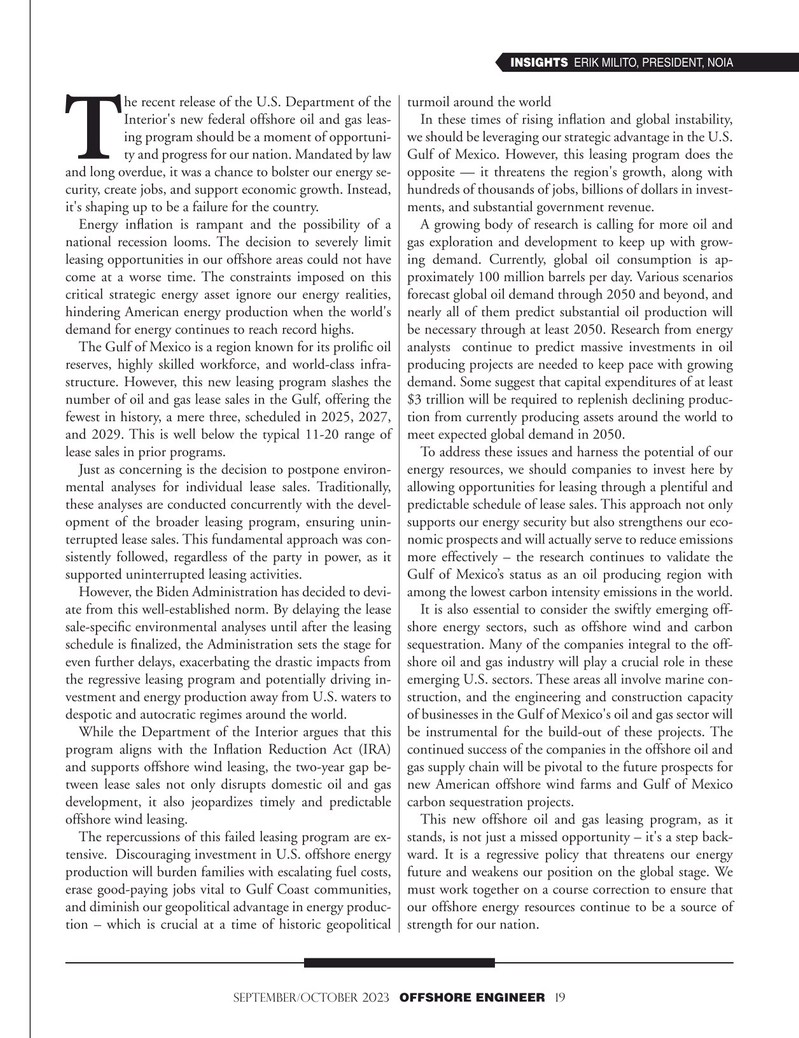
Page 18: of Offshore Engineer Magazine (Sep/Oct 2023)
Read this page in Pdf, Flash or Html5 edition of Sep/Oct 2023 Offshore Engineer Magazine
INSIGHTS ERIK MILITO, PRESIDENT, NOIA he recent release of the U.S. Department of the turmoil around the world
Interior's new federal offshore oil and gas leas- In these times of rising in?ation and global instability, ing program should be a moment of opportuni- we should be leveraging our strategic advantage in the U.S.
T ty and progress for our nation. Mandated by law Gulf of Mexico. However, this leasing program does the and long overdue, it was a chance to bolster our energy se- opposite — it threatens the region's growth, along with curity, create jobs, and support economic growth. Instead, hundreds of thousands of jobs, billions of dollars in invest- it's shaping up to be a failure for the country. ments, and substantial government revenue.
Energy in?ation is rampant and the possibility of a A growing body of research is calling for more oil and national recession looms. The decision to severely limit gas exploration and development to keep up with grow- leasing opportunities in our offshore areas could not have ing demand. Currently, global oil consumption is ap- come at a worse time. The constraints imposed on this proximately 100 million barrels per day. Various scenarios critical strategic energy asset ignore our energy realities, forecast global oil demand through 2050 and beyond, and hindering American energy production when the world's nearly all of them predict substantial oil production will demand for energy continues to reach record highs. be necessary through at least 2050. Research from energy
The Gulf of Mexico is a region known for its proli?c oil analysts continue to predict massive investments in oil reserves, highly skilled workforce, and world-class infra- producing projects are needed to keep pace with growing structure. However, this new leasing program slashes the demand. Some suggest that capital expenditures of at least number of oil and gas lease sales in the Gulf, offering the $3 trillion will be required to replenish declining produc- fewest in history, a mere three, scheduled in 2025, 2027, tion from currently producing assets around the world to and 2029. This is well below the typical 11-20 range of meet expected global demand in 2050.
lease sales in prior programs. To address these issues and harness the potential of our
Just as concerning is the decision to postpone environ- energy resources, we should companies to invest here by mental analyses for individual lease sales. Traditionally, allowing opportunities for leasing through a plentiful and these analyses are conducted concurrently with the devel- predictable schedule of lease sales. This approach not only opment of the broader leasing program, ensuring unin- supports our energy security but also strengthens our eco- terrupted lease sales. This fundamental approach was con- nomic prospects and will actually serve to reduce emissions sistently followed, regardless of the party in power, as it more effectively – the research continues to validate the supported uninterrupted leasing activities. Gulf of Mexico’s status as an oil producing region with
However, the Biden Administration has decided to devi- among the lowest carbon intensity emissions in the world.
ate from this well-established norm. By delaying the lease It is also essential to consider the swiftly emerging off- sale-speci?c environmental analyses until after the leasing shore energy sectors, such as offshore wind and carbon schedule is ?nalized, the Administration sets the stage for sequestration. Many of the companies integral to the off- even further delays, exacerbating the drastic impacts from shore oil and gas industry will play a crucial role in these the regressive leasing program and potentially driving in- emerging U.S. sectors. These areas all involve marine con- vestment and energy production away from U.S. waters to struction, and the engineering and construction capacity despotic and autocratic regimes around the world. of businesses in the Gulf of Mexico's oil and gas sector will
While the Department of the Interior argues that this be instrumental for the build-out of these projects. The program aligns with the In?ation Reduction Act (IRA) continued success of the companies in the offshore oil and and supports offshore wind leasing, the two-year gap be- gas supply chain will be pivotal to the future prospects for tween lease sales not only disrupts domestic oil and gas new American offshore wind farms and Gulf of Mexico development, it also jeopardizes timely and predictable carbon sequestration projects.
offshore wind leasing. This new offshore oil and gas leasing program, as it
The repercussions of this failed leasing program are ex- stands, is not just a missed opportunity – it's a step back- tensive. Discouraging investment in U.S. offshore energy ward. It is a regressive policy that threatens our energy production will burden families with escalating fuel costs, future and weakens our position on the global stage. We erase good-paying jobs vital to Gulf Coast communities, must work together on a course correction to ensure that and diminish our geopolitical advantage in energy produc- our offshore energy resources continue to be a source of tion – which is crucial at a time of historic geopolitical strength for our nation.
september/october 2023 OFFSHORE ENGINEER 19

 17
17

 19
19